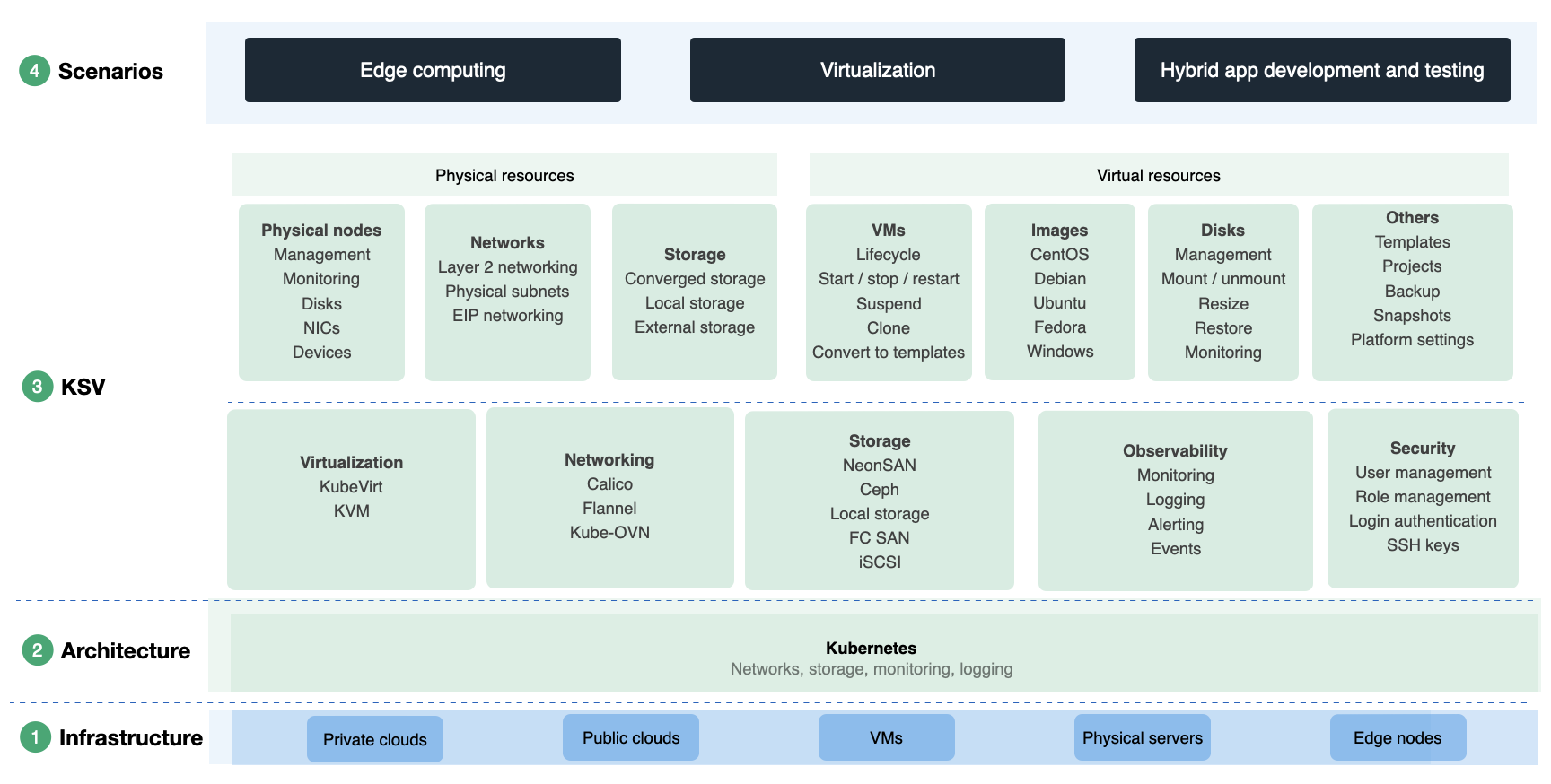What is KSV?
Describes the features and scenarios of KSV.
KubeSphere Virtualization (KSV) is a lightweight VM management platform built on top of KubeSphere. KSV supports deployment in single-node and multi-node modes and provides an enterprise-grade service of virtualization to meet business needs of individual and enterprise users in diverse scenarios. KSV can help you reduce hardware costs in early stages and allows you to create VMs based on business requirements. This way, you can develop and deploy applications in an efficient manner.
On top of the cloud-native architecture Kubernetes, KSV is more lightweight, flexible, and open than legacy virtualization services. KSV can also provide capabilities of service self-healing, auto scaling, and flexible scheduling.
Benefits
KSV can provide compute and storage resources with the following benefits:
Low cost: supports a minimum specification of 4 CPU cores and 8 GB memory and multi-node clusters.
Simple operation: provides an easy-to-use web console to help you monitor all resources for enterprise hardware virtualization and enables service self-healing.
Quick installation: allows you to deploy and update a cluster in 20 minutes.
Quick response: allows you to create and resize VMs within seconds.
Excellent compatibility: frees you from the dependency of the underlying infrastructure. You can create VMs on any servers that suppport virtualization.
Connection to containers: seamlessly connects to KubeSphere and integrates VMs and containers.
Architecture
On top of the cloud-native architecture of Kubernetes, KSV abstracts away the complexities of the infrastructure and basic configuration. You can run KSV in development or testing environments of various types, from private clouds, public clouds, VMs, physical servers, to edge nodes. KSV provides a range of functional modules, such as physical nodes, networks, storage, VMs, images, disks, and security groups.
The following figure shows the architecture.

Underlying logic
The following table describes the underlying logic of KSV.
| Module | Description |
|---|---|
VMs | By using the KubeVirt plug-in, KSV allows you to manage the lifecycle, status, and connection of each VM. |
Networks | KSV runs on top of containers, which requires more NICs for networking. KSV allows you to use NICs on VMs in containers. At the underlying layer, KSV uses Multus to enable multiple NICs for containers. KSV supports Macvtap for VMs and integrates Kube-OVN to enable software-defined networking (SDN). Kube-OVN provides underlay and overlay network types. You can select a network type based on business requirements. |
Images | KSV uses Contexts and Dependency Injection (CDI) to import images into persistent volumes (PVs) and creates system disks by cloning PVs. |
Storage | KSV can integrate into the Kubernetes Container Storage Interface (CSI) for storage resource management. KSV uses open-source Ceph block devices and can connect to commercial storage systems by using CSI. |
Security groups | KSV integrates Kube-OVN and enables security groups by using the NICs powered by Kube-OVN. |
Bandwidth limits | KSV integrates Kube-OVN and enables bandwidth limits by using the NICs powered by Kube-OVN. |
Monitoring metrics | On top of the native Kubernetes Prometheus monitoring system, KSV allows you to configure, collect, store, and query cluster monitoring data. |
Alerts and monitoring | On top of the native Kubernetes Prometheus monitoring system, KSV allows you to configure, collect, store, and query cluster alert data. |
Log queries | On top of the native Kubernetes Fluent Bit and Elasticsearch, KSV allows you to collect, store, and query log data. |
Billing
KSV provides the following types of editions: Basic, Developer, and Enterprise. The Basic Edition is suitable for individual and micro enterprises. In this edition, you can deploy up to 3 nodes free of charge. The Developer and Enterprise editions provide more comprehensive virtualization services and allow middle and large enterprises to deploy more nodes. For more information about billing and capabilities of each edition, see Editions.
Pre-deployment checklists
Before you deploy a KSV cluster, use the following checklists to ensure you have a prepared environment:
Server nodes
KSV supports Linux and the kernel version must be 4.0 or later. We recommend that you use one of the following OSs: Ubuntu 18.04, Ubuntu 20.04, CentOS 7.9, Unity Operating System (UOS), Kylin V10, and EulerOS.
Network planning
We recommend that you plan two networks for the following use:
Management network: the network where the server nodes of KSV resides. We recommend that you use private VLANs and connect switches using trunks.
Business network: the network where virtual resources reside. You can configure multiple VLANs based on business requirements and connect vSwitches using trunks.
Security
KSV provides security groups to control inbound and outbound traffic of VMs in the security groups. This improves the security of virtualization services. For more information, see Security groups.
To ensure business continuity, KSV also provides snapshots for backup. We recommend that you create snapshots for disks and VMs to enable disaster recovery.

